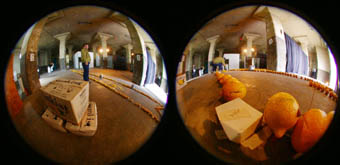ISEA Nagoya: hi-tech, low output
Bruce Mowson

Kaoru Motomiya, California lemon sings a song
photo Megan Jones
Kaoru Motomiya, California lemon sings a song
What would you expect of an International Symposium on Electronic Art? It suggests Peter Stuyvesant—yout international passport to new media pleasure—sweeping views, gold jewellery and sophisticated fashion. A symposium is a formal intellectual presentation and/or a drinking party in the classical Greek style. Electronic art sounds a bit, well, nerdish, leaving you with…a Microsoft conference in an interactive chateau in Aspen?
ISEA 2002 was held in Nagoya, a regional centre 2 hours south of Tokyo. The official theme, Orai, loosely means traffic—comings and goings, contract and communication—and participants were encouraged to respond to this. The symposium’s program, which included exhibitions, academic presentations and performances, was located around a small harbour. Once the official port, it has been re-zoned as a public space, including an aquarium, small museums and a park. About 100 academic presentations were given across 4 days, and 57 installations were housed in 2 huge, disused shipping warehouses.
Kaoru Motomiya’s California lemon sings a song was a highlight of the exhibition. Lemons joined by wires to digital chips produced simple melodies generated by electrical currents from the fruit acid. The audience must kneel, remove the lids from coin-sized boxes on the floor and put their ears almost to the ground to hear the work. First installed at the Headland Arts Centre, California, the piece was made in the shape of a missile, at 1:1 scale, using the same number of lemons as people and dogs who worked in an adjoining former missile base. The missile was pointed at Japan, where the lemons were to be exported. In Japan this work built upon the strong atmosphere of the abandoned warehouses in which the exhibition was held.
Another highlight was Date and Time, a retrospective of Californian video artist Jim Campbell held in the Nagoya City Art Museum. Campbell’s work uses monitor-sized fields of LEDs, rather than monitors or projection, as the display stage of his video pieces. While this technique recalls pointillism, the grid is coarser, heightening the level of abstraction. In pieces such as Running, Falling the movement of a human within the frame becomes intriguingly ape-like, recalling the ambiguous humanity of the opening scenes of 2001: A Space Odyssey.
The performance program favoured live sound/video presentations in the currently popular synchronised eye-candy style. Standing out from the crowd was Faustentechnology, a live audio/visual performance by Quebec duo Alain Thibault and Jan Breuleux. Their tight, minimal beat composition and video footage of abstracted land and cityscapes allowed for dynamic connections between the sounds and images, building on filmmaking techniques. Akiyo Tsubakihara and Yosuke Kawamura’s performance Ambiguous Senses/Misleading Feelings 2, also built upon established techniques, exploring video projection’s possibilities as a spotlight, highlighting small cropped squares of light on the dancer’s body.
Within the academic program, Alex Baghat’s presentation of the public-space noise works of Ultra-Red and Infernal Noise Brigade was engaging and well supported by documentary examples of the artwork. Shawn Decker’s brief talk illuminated his innovative sound installation practice, which employs low tech means in effective ways—using small motor and microprocessor units to trigger sound sculptures that display evolving group behaviours, and various resonators—such as metal buckets—acting as speakers. Decker’s work was inaudible amongst the soupy noise inside the exhibition space. Similarly compromised was Melinda Rackham’s engaging virtual space Empyrean and UK work, 32 000 Points of Light, a sound/video projection by Andy Gracie, Alex Bradley, Duncan Speakman, Matt Mawford and Jessica Marlow. The careful composition and otherwise seductive qualities of these soundtracks were also lost in the noisy setting.
Further serious problems existed—both with the local co-ordinating organisation, Media-Select, and the parent group who oversee the ongoing activities. ISEA is curated by committee, arguably allowing greater diversity and more artists who are less well-known into the program. This approach favours larger scale presentation, as a greater number of interests are represented. However, while a theme usually brings focus, in Nagoya the program was mediocre and half-baked. All the work in the exhibition suffered from overcrowding and most artists were disappointed by the result. By contrast the organisational style of the Multimedia Arts Asia Pacific (MAAP) resulted in a focused and dynamic event. Held recently in Beijing and curated by Kim Machan, MAAP was streets ahead of ISEA in its high standard of presentation, diverse works, artistic and intellectual rigour (see report in RT 54, April-May). Further, all the works in MAAP were operational and ready for public presentation, which could not be said of someworks in ISEA.
The massive number of installations, performances and presentations is an ongoing issue for ISEA and feedback from those who have experienced prior festivals indicates similar problems. Despite a huge production staff of committee members and volunteers there is simply too much, spread over too many venues. ISEA, contrary to its image, is poorly resourced—most artists sourced presentation costs independently. The million dollars necessary to properly mount ISEA’s ambitious program is not there.
More problematic, however, is ISEA’s context. Its original purpose to create international connections for artists in the emerging field of Electronic Art no longer seems relevant 14 years later. Roy Ascott, head of the CAII-Star post-doctoral research organization in the UK, suggested a name change from Electronic to Emergent Art, questioning the absence of work from bio-art, molecular and nano-technology, genetics, consciousness research and paranormal perception.
ISEA needs to shape up or ship out…but whaddya know—their next show is on a very big BOAT!—in the Baltic Sea, with the sharper figure of ex-ANAT Director Amanda McDonald Crowley at the helm as Executive Producer. Its organisational mechanism is already well underway.
ISEA 2002, 11th International Symposium on Electronic Art, Nagoya, Japan, Oct 27-31, 2002.
RealTime issue #53 Feb-March 2003 pg. 24






